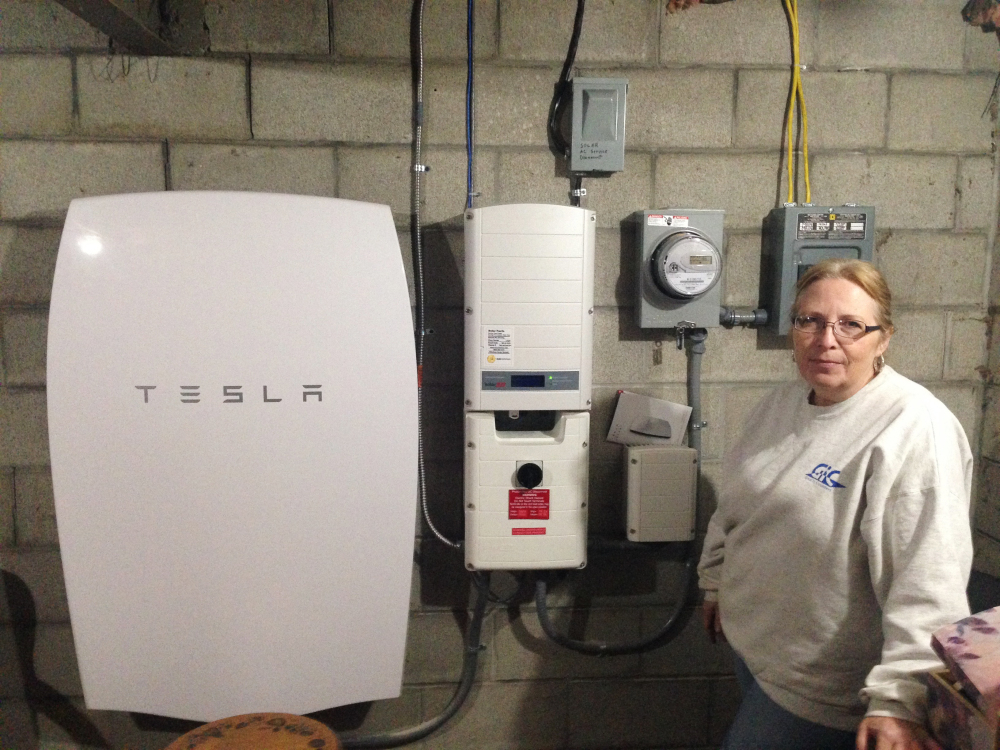MIDDLETOWN SPRINGS, Vt. — Rhonda “Honey” Phillips keeps her own cows and garden at her small, hillside homestead, and now is pushing self-sufficiency in a more high-tech direction. This year, she installed new solar panels just downhill from her modest house and hung a Tesla Powerwall backup battery on her basement wall, to charge up when it’s sunny and draw down when it isn’t.
“My grandfather used to say, ‘Whatever you can see is what you should be taking care of,”‘ said Phillips, 57, whose family has been in Vermont since the 1700s. With shorter winters and hotter temperatures in the summer, Phillips is convinced she’s seeing climate change.
In her renewable energy project, Phillips got help from the Vermont solar company SunCommon and Vermont’s major electric company, Green Mountain Power.
GMP has been pushing to be a leader in the search for the holy grail of renewable energy – economical batteries to store energy from wind farms and solar panels for those times when the sun doesn’t shine and the wind doesn’t blow.
In an interview last year, the company’s CEO, Mary Powell, told The Associated Press that batteries would be a linchpin in a newly envisioned future for electrical energy. They would store solar energy and provide backup power during outages and put electricity on the grid at times of peak demand.
All signs are that it’s happening.
Phillips is one of 20 GMP customers to have installed Tesla Powerwalls – 70 more are in the queue. GMP charges $37 a month over the life of the battery, or allows customers to buy them upfront for about $7,000 installed.
Email and phone messages left for a Tesla spokeswoman drew no immediate response.
On a larger scale, GMP in the summer of 2015 put into service a solar and battery storage project on the former Stafford Hill landfill in Rutland. The system has multiple purposes. During long-duration power outages, it can be used for electricity to serve the emergency shelter that would be set up at the neighboring high school, said Dan Mackey, whose job title at GMP is “innovation champion.”
But on an August afternoon, when air conditioners were cranking and the six-state New England region was hitting its annual peak demand, the Stafford Hill project was used to load the batteries’ 2.2 megawatts of power onto the grid. GMP was able to avoid its spot power purchases during a time of peak prices. The total savings: $200,000, the company said.
“Through careful planning, we anticipated when the New England peak load would occur, and worked tirelessly to ensure that control technology would enable us to draw down the power from Stafford Hill providing significant benefit to customers,” Powell said.
Last week, the company took what it called “the next step in the evolution of energy.” It became the first utility to announce a package of products and services designed to enable a customer to go off the grid.
It used to be anathema for utilities to encourage customers to disconnect from the power grid. But spokeswoman Kristin Carlson said if the company can reduce the miles of line it has to run to homes and businesses in remote places, it could be a cost savings to everyone.
“This off-grid suite of products illustrates very well where energy is going and for us at GMP. We are leading the revolution toward clean, affordable, local and highly reliable power,” Powell said.
Send questions/comments to the editors.



Success. Please wait for the page to reload. If the page does not reload within 5 seconds, please refresh the page.
Enter your email and password to access comments.
Hi, to comment on stories you must . This profile is in addition to your subscription and website login.
Already have a commenting profile? .
Invalid username/password.
Please check your email to confirm and complete your registration.
Only subscribers are eligible to post comments. Please subscribe or login first for digital access. Here’s why.
Use the form below to reset your password. When you've submitted your account email, we will send an email with a reset code.